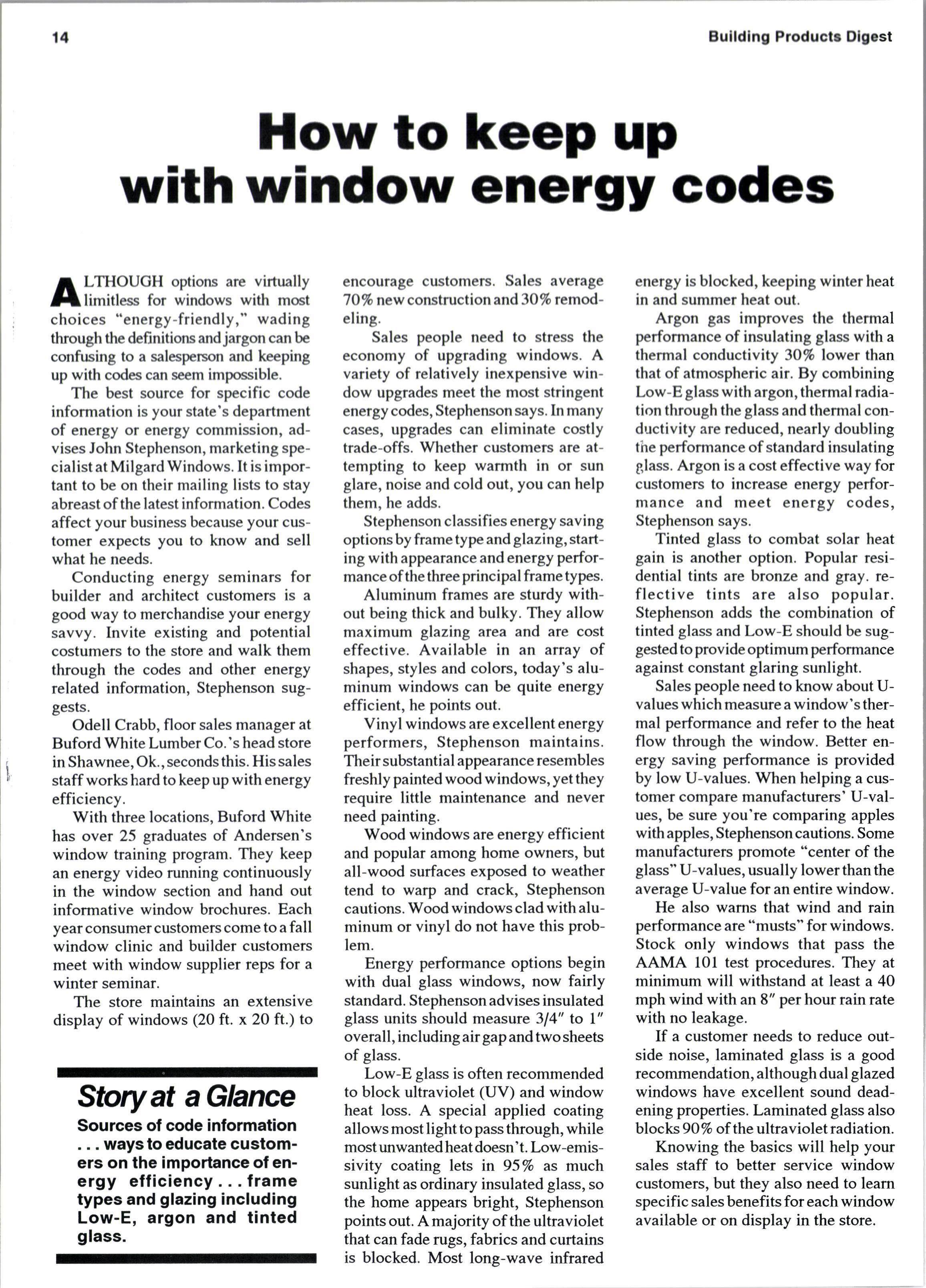
3 minute read
How to keep up with window energy codes
I LTHOUGH options arc virtually fllimitless for windows with most choices "energy-friendly," wading through the definitions andjargon can be confirsing to a satesperson and keeping up with codes can seem impossible.
The best source for specific code information is your state's department of energy or energy commission, advises John Stephenson, marketing specialist at Milgard Windows. It is important to be on their mailing lists to stay abreast of the latest information. Codes affect your business because your customer expects you to know and sell what he needs.
Conducting energy seminars for builder and architect customers is a good way to merchandise your energy savvy. Invite existing and potential costumers to the store and walk them through the codes and other energy related information, Stephenson suggests.
Odell Crabb, floor sales manager at Buford White Lumber Co.'s head store in Shawnee, Ok., seconds this. Hissales staff works hard to keep up with energy efficiency.
With three locations, Buford White has over 25 graduates of Andersen's window training program. They keep an energy video running continuously in the window section and hand out informative window brochures. Each year consumer customers come to a fall window clinic and builder customers meet with window supplier reps for a winter seminar.
The store maintains an extensive display of windows (20 ft. x 20 ft.) to
Story at a Glance
encourage customers. Sales average 70% new construction and 30% remodeling.
Sales people need to stress the economy of upgrading windows. A variety of relatively inexpensive window upgrades meet the most stringent energy codes, Stephenson says. In many cases, upgrades can eliminate costly trade-offs. Whether customers are attempting to keep warmth in or sun glare, noise and cold out, you can help them, he adds.
Stephenson classifi es energy saving options by frame type and glazing, starting with appearance and energy performance of the three principal frame types.
Aluminum frames are sturdy without being thick and bulky. They allow maximum glazing area and are cost effective. Available in an array of shapes, styles and colors, today's aluminum windows can be quite energy efficient, he points out.
Vinyl windows are excellent energy performers, Stephenson maintains. Their substanti al appearance resembles freshly painted wood windows, yet they require little maintenance and never need painting.
Wood windows are energy efficient and popular among home owners, but all-wood surfaces exposed to weather tend to warp and crack, Stephenson cautions. Wood windows clad with aluminum or vinyl do not have this problem.
Energy performance options begin with dual glass windows, now fairly standard. Stephenson advises insulated glass units should measure 314" to l" overall, including air gap and two sheets of glass.
Low-E glass is often recommended to block ultraviolet (UV) and window heat loss. A special applied coating allows most light to pass through, while mostunwantedheatdoesn't. Low-emissivity coating lets in 95% as much sunlight as ordinary insulated glass, so the home appears bright, Stephenson points out. A majority of the ultraviolet that can fade rugs, fabrics and curtains is blocked. Most long-wave infrared energy is blocked, keeping winter heat in and summer heat out.
Argon gas improves the thermal performance of insulating glass with a thermal conductivity 30% lower than that of atmospheric air. By combining Low-E glass with argon, thermal radiation through the glass and thermal conductivity are reduced, nearly doubling the performance of standard insulating p,lass. Argon is a cost effective way for customers to increase energy performance and meet energy codes, Stephenson says.
Tinted glass to combat solar heat gain is another option. Popular residential tints are bronze and gray. reflective tints are also popular. Stephenson adds the combination of tinted glass and Low-E should be suggesied to provide optimum performance against constant glaring sunlight.
Sales people need to know about Uvalues which measure a window's thermal performance and refer to the heat flow through the window. Better energy saving performance is provided by low U-values. When helping a customer compare manufacturers' U-values, be sure you're comparing apples with apples, Stephenson cautions. Some manufacturers promote "center of the glass" U-values, usually lowerthanthe average U-value for an entire window.
He also warns that wind and rain performance are "musts" for windows. Stock only windows that pass the AAMA 101 test procedures. They at minimum will withstand at least a 40 mph wind with an 8" per hour rain rate with no leakage.
If a customer needs to reduce outside noise, laminated glass is a good recommendation, althoughdual glazed windows have excellent sound deadening properties. Laminated glass also blocks 90% of the ultravioletradiation.
Knowing the basics will help your sales staff to better service window customers, but they also need to learn specific sales benefits for each window available or on display in the store.










